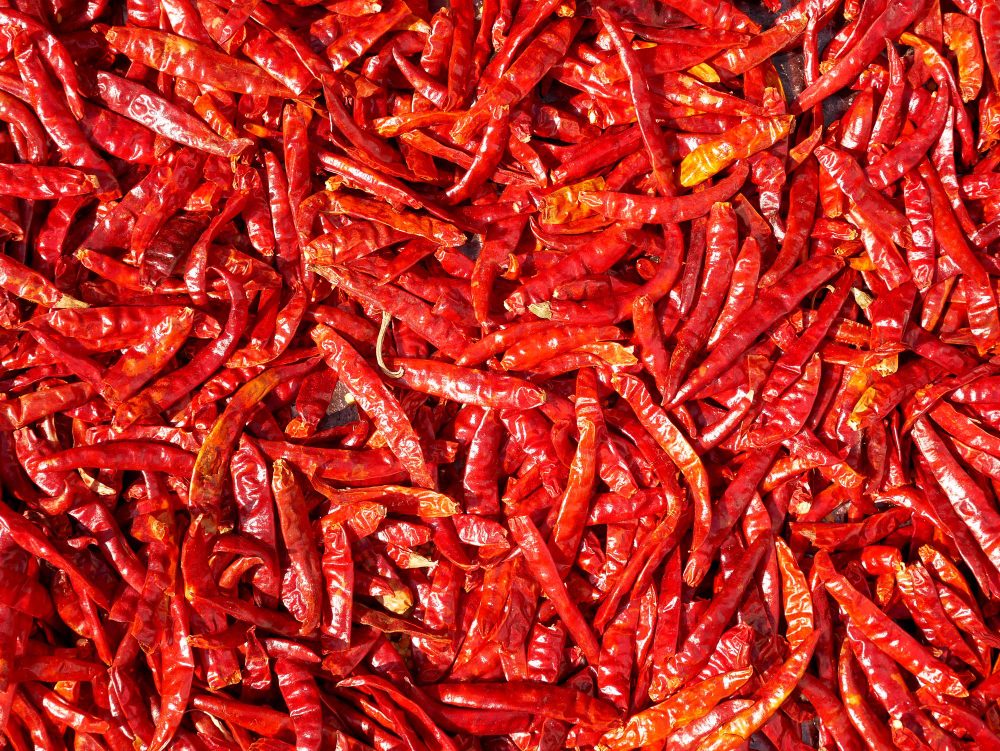As a leading Indian exporter of spices, we understand that buying dry red chilli in bulk is more than just comparing prices per kilogram. Whether you’re a food processor, distributor, spice brand, or industrial buyer, selecting the right chilli variety, grade, and supplier directly affects your product quality, compliance, and margins.
India, being the largest producer and exporter of red chillies, offers an unmatched range of pungency levels, vibrant colours, and drying techniques. However, the diversity also means buyers must do their due diligence.
In this article, we will walk you through the key factors to consider when buying dry red chilli in bulk, helping you make informed decisions that ensure consistency, compliance, and cost-efficiency.
Identify the Right Chilli Variety Based on Your Market
The most important decision is selecting the appropriate dry red chilli variety that matches your application and customer expectations.
- Need strong heat? Go for Teja S17 (80,000–100,000 SHU) or Dhani (tiny but pungent).
- Looking for rich red colour with low heat? opt for Byadgi or Kashmiri chillies.
- Balanced flavour with moderate pungency? Choose Guntur Sannam (334).
- Unique South Indian aroma or texture? Consider Mundu chilli.
Each market has preferences. Southeast Asia often demands pungent chillies for sauces; Europe and the Middle East prefer low-heat varieties for colour extraction. Knowing your consumer trends helps define the exact product fit.
Check for colour (ASTA Value) and Pungency (SHU)
For bulk buyers, two technical values are crucial:
- ASTA colour Value: Indicates the intensity of red colour. High ASTA (100–200) means vibrant appearance-ideal for aesthetic appeal or pigment extraction.
- Scoville Heat Units (SHU): Measures chilli pungency. Low SHU (1,000–10,000) means mild spice. High SHU (50,000–100,000+) indicates extreme heat.
For example:
- Byadgi: High ASTA (150–200), Low SHU (6,000–15,000)
- Teja: Moderate ASTA (60–80), High SHU (90,000+)
- Kashmiri: High ASTA (130+), Very Low SHU (1,000–2,000)
Always ask for lab test reports before confirming bulk orders. Reputable exporters provide third-party test results to back these metrics.
Choose Between Stemless and With-Stem Red Chillies
International buyers must decide whether they need with-stem or stemless dry red chillies.
- Stemless Chillies: These are cleaned and deseeded, ready for direct grinding. Ideal for spice powder manufacturers, processors, and packagers.
- With-Stem Chillies: Typically preferred when shelf life is the priority or when chillies are sold as whole pods.
While stemless chillies cost slightly more due to additional processing, they save labour, reduce foreign matter, and ensure cleaner packaging. Many food manufacturers prefer this variant for quality and efficiency.
Ensure Proper Drying and Moisture Content
Moisture content in dry red chilli should be below 12% to prevent fungal growth, aflatoxin, and quality degradation during transit. Traditionally, Indian chillies are sun-dried, but top exporters also use mechanical dryers to ensure consistent moisture removal.
Ask your supplier:
- What is the final moisture content?
- Is drying done under hygienic conditions?
- Are the chillies stored in moisture-proof packaging?
Excess moisture in bulk shipments can lead to container rejection or product spoilage. Don’t compromise on drying standards.
Review Cleanliness, Grading, and Sorting
Grading standards vary from one exporter to another. Ensure your bulk order is machine cleaned and manually sorted to eliminate:
- Loose stems
- Dust
- Broken pods
- Foreign matter (threads, leaves, stones)
For premium retail brands or spice blends, uniformity in pod size, shape, and cleanliness adds immense value. Request sample photos or videos of actual lots or processing facilities before confirming your order.
Understand the Supply Chain and Harvest Timelines
India’s dry red chilli harvest generally occurs between February and April, but stocks are available year-round from cold storage and processing units. Knowing harvest cycles helps you plan your procurement efficiently.
Buying during peak harvest months ensures:
- Fresher stock
- Better pricing
- Wider availability of grades and varieties
Off-season buying can lead to higher prices or older inventory. Work with a supplier who has reliable storage and traceability practices.
Packaging, Shelf Life, and Container Loading
Bulk buyers must ensure that dry red chillies are packed for international transit. Common packaging options include:
- 25kg / 50kg polypropylene woven bags
- 10kg / 25kg paper or jute sacks
- Vacuum or nitrogen-flushed packs (for premium grades)
Ask for pallets, fumigation, or container liners depending on your port regulations. Export-grade dry chillies have a shelf life of 9 to 12 months when stored in cool, dry conditions.
Certifications and Compliance for Import
Ensure that your Indian exporter is compliant with international food safety standards. The following certifications and documentation are recommended:
- FSSAI, Spice Board of India, APEDA Registration
- EU Pesticide Residue Compliance
- Phytosanitary Certificate (PQ)
- Certificate of Origin (COO)
- Aflatoxin & Moisture Test Reports
- Organic/NPOP or USDA Organic
Some importing countries (e.g., the EU) have strict pesticide and aflatoxin limits. Always request third-party lab testing before finalizing any bulk deal.
Build a Long-Term Relationship with a Trusted Exporter
In bulk spice trading, trust is everything. Work with an exporter who:
- Offers transparent documentation
- Shares videos/samples regularly
- Provides customized logistics solutions
- Has experience exporting to your country or region
A long-term partnership helps you get better rates, priority access to new stock, and smoother communication. Reliable Indian exporters will always guide you on the best sourcing schedule and variety selection based on your market.
Price Isn’t Everything: Balance Quality and Consistency
While price is important, don’t fall for unrealistically low quotes. Often, cheaper lots mean older chillies, improper drying, inconsistent grading, or non-compliance with international standards. These issues can result in rejected shipments or brand damage.
Instead, focus on:
- Consistent heat/colour profile
- Clean, sorted pods
- Low moisture
- Clear compliance
- Scalable supply for future needs
This balance ensures that your business delivers top-quality products to end consumers, securing repeat demand.



